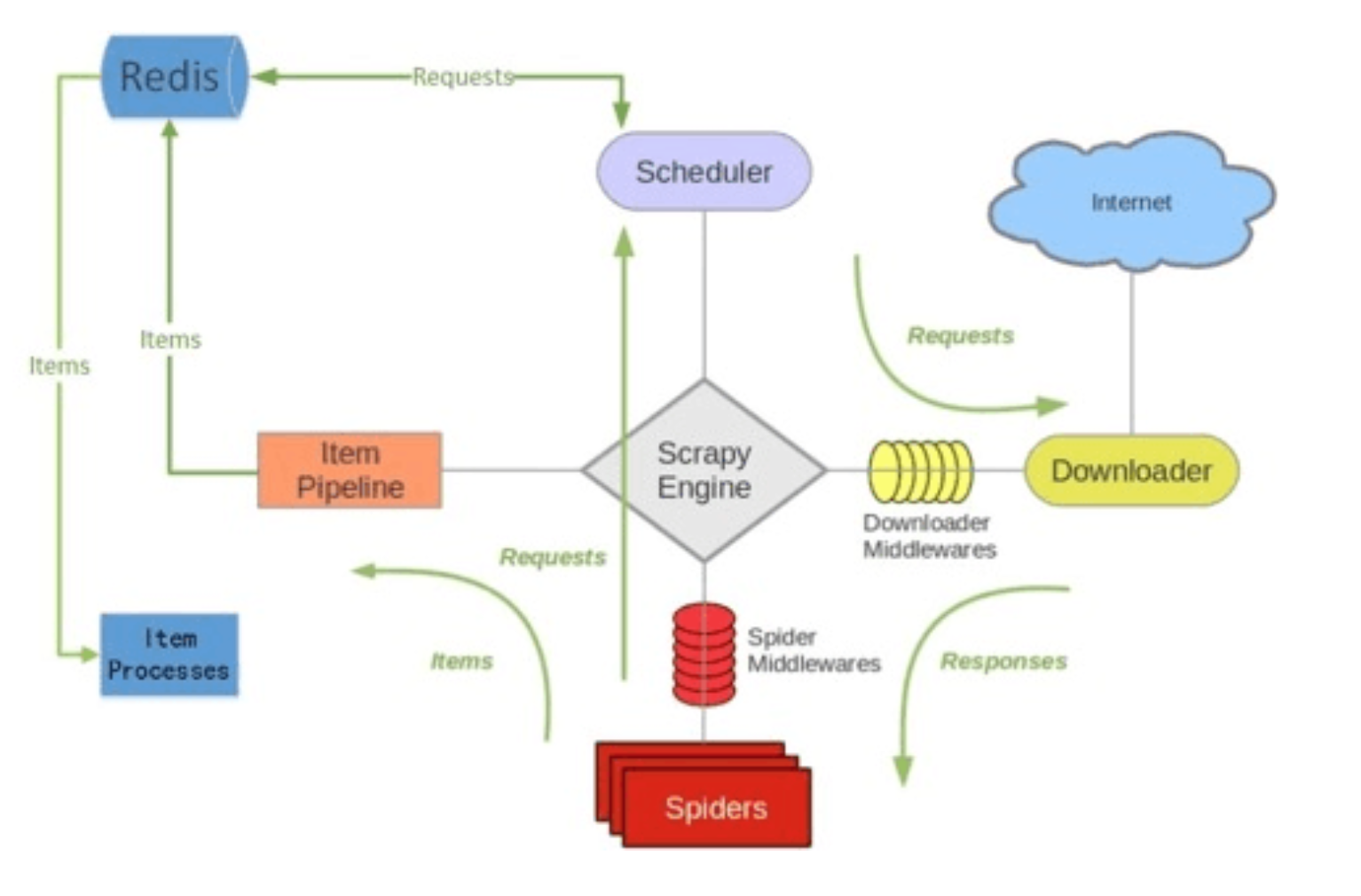Scrapy-Redis分布式策略
原理图:

假设有四台电脑:Windows 10、Mac OS X、Ubuntu 16.04、CentOS 7.2,任意一台电脑都可以作为 Master端 或 Slaver端,比如:
Master端(核心服务器) :使用 Windows 10,搭建一个Redis数据库,不负责爬取,只负责url指纹判重、Request的分配,以及数据的存储
Slaver端(爬虫程序执行端) :使用 Mac OS X 、Ubuntu 16.04、CentOS 7.2,负责执行爬虫程序,运行过程中提交新的Request给Master
首先Slaver端从Master端拿任务(Request、url)进行数据抓取,Slaver抓取数据的同时,产生新任务的Request便提交给 Master 处理;
Master端只有一个Redis数据库,负责将未处理的Request去重和任务分配,将处理后的Request加入待爬队列,并且存储爬取的数据。
Scrapy-Redis默认使用的就是这种策略,我们实现起来很简单,因为任务调度等工作Scrapy-Redis都已经帮我们做好了,我们只需要继承RedisSpider、指定redis_key就行了。
缺点是,Scrapy-Redis调度的任务是Request对象,里面信息量比较大(不仅包含url,还有callback函数、headers等信息),可能导致的结果就是会降低爬虫速度、而且会占用Redis大量的存储空间,所以如果要保证效率,那么就需要一定硬件水平。
环境准备
安装scrapy
pip install scrapy
安装scrapy-redis
pip install scrapy-redis
安装redis
windows版redis软件下载
密码:oopq
创建项目
scrapy startproject 项目名称
拉勾网实战
向原有settings.py文件中添加
# url指纹过滤器 DUPEFILTER_CLASS = "scrapy_redis.dupefilter.RFPDupeFilter" # 调度器 SCHEDULER = "scrapy_redis.scheduler.Scheduler" # 设置爬虫是否可以中断 SCHEDULER_PERSIST = True # 设置请求队列类型 # SCHEDULER_QUEUE_CLASS = "scrapy_redis.queue.SpiderPriorityQueue" # 按优先级入队列 # SCHEDULER_QUEUE_CLASS = "scrapy_redis.queue.SpiderQueue" # 按照队列模式先进先出 SCHEDULER_QUEUE_CLASS = "scrapy_redis.queue.SpiderStack" # 按照栈进行请求的调度先进后出 # 配置redis管道文件,权重数字相对最大 ITEM_PIPELINES = { 'scrapy_redis.pipelines.RedisPipeline': 999, # redis管道文件,自动把数据加载到redis } # redis 连接配置 REDIS_HOST = '127.0.0.1' REDIS_PORT = 6379 REDIS_PARAMS = { 'password' : '123456', # 密码 'db' : 1 # 指定使用哪个数据库 }
并修改settings.py文件ROBOTSTXT_OBEY = False
Spider文件
本爬虫实现了将所有爬虫请求获取的数据写入到Redis服务器中
import scrapy from scrapy.linkextractors import LinkExtractor from scrapy.spiders import CrawlSpider, Rule from scrapy_redis.spiders import RedisCrawlSpider from scr_redis.items import LaGouItem import re import time from datetime import datetime from datetime import timedelta class BaiduSpider(RedisCrawlSpider): #继承RedisCrawlSpider 类 name = 'lagou' allowed_domains = ['lagou.com'] # start_urls = ['http://www.baidu.com/'] redis_key = 'start_url' #设置redis键名启动 rules = ( # Rule(LinkExtractor(allow=r''), callback='parse_item', follow=True), # #搜索 Rule(LinkExtractor(allow=(r'lagou.com/jobs/list_',), tags=('form',), attrs=('action',)), follow=True), # #公司招聘 Rule(LinkExtractor(allow=(r'lagou\.com/gongsi/',), tags=('a',), attrs=('href',)), follow=True), # 公司列表 Rule(LinkExtractor(allow=(r'/gongsi/j\d+\.html',), tags=('a',), attrs=('href',)), follow=True), # 校园招聘 Rule(LinkExtractor(allow=(r'xiaoyuan\.lagou\.com',), tags=('a',), attrs=('href',)), follow=True), # 匹配校园分类 Rule(LinkExtractor(allow=(r'isSchoolJob',), tags=('a',), attrs=('href',)), follow=True), # # 详情页 Rule(LinkExtractor(allow=(r'jobs/\d+\.html',), tags=('a',), attrs=('href',)), callback='parse_item', follow=False), ) num_pattern = re.compile(r'\d+') # 提取数字正则 custom_settings = { 'DEFAULT_REQUEST_HEADERS' : { "Host": "www.lagou.com", "Connection": "keep-alive", "User-Agent": "Mozilla/5.0 (Windows NT 10.0; Win64; x64) AppleWebKit/537.36 (KHTML, like Gecko) Chrome/62.0.3202.94 Safari/537.36", "Content-type": "application/json;charset=utf-8", "Accept": "*/*", "Referer": "https://www.lagou.com", "Accept-Language": "zh-CN,zh;q=0.9", "Cookie": "user_trace_token=20171116192426-b45997e2-cac0-11e7-98fd-5254005c3644; LGUID=20171116192426-b4599a6d-cac0-11e7-98fd-5254005c3644; index_location_city=%E5%85%A8%E5%9B%BD; JSESSIONID=ABAAABAAAGFABEFC0E3267F681504E5726030548F107348; _gat=1; X_HTTP_TOKEN=d8b7e352a862bb108b4fd1b63f7d11a7; _gid=GA1.2.1718159851.1510831466; _ga=GA1.2.106845767.1510831466; Hm_lvt_4233e74dff0ae5bd0a3d81c6ccf756e6=1510836765,1510836769,1510837049,1510838482; Hm_lpvt_4233e74dff0ae5bd0a3d81c6ccf756e6=1510839167; LGSID=20171116204415-da8c7971-cacb-11e7-930c-525400f775ce; LGRID=20171116213247-a2658795-cad2-11e7-9360-525400f775ce", }, 'COOKIES_ENABLED' : False, 'CONCURRENT_REQUESTS' : 5, } def parse_item(self, response): item = LaGouItem() title = response.css('span.name::text').extract()[0] url = response.url spans = response.xpath('//dd[@class="job_request"]//span') salary = spans[0].css('span::text').extract()[0] #薪资 city =self.splits(spans[1].css('span::text').extract()[0])#工作城市 start,end= self.asks(self.splits(spans[2].css('span::text').extract()[0] ))#经验 edu = self.splits(spans[3].css("span::text").extract()[0] ) #学历 job_type = spans[4].css('span::text').extract()[0] #工作类型 label = "-".join(response.xpath('//ul[@class="position-label clearfix"]//li/text()').extract()) #标签 publish_time =self.times(response.xpath('//p[@class="publish_time"]//text()').extract()[0].strip('\xa0 发布于拉勾网')) #发布时间 tempy = response.xpath('//dd[@class="job-advantage"]//p/text()').extract()[0] #在职业诱惑 discription =''.join([''.join(i.split()) for i in response.xpath('//dd[@class="job_bt"]//div//text()').extract()]) #岗位职责 addr = '-'.join(response.xpath('//div[@class="work_addr"]//a/text()').extract()[:-1]) address = ''.join( ''.join(i.split()) for i in response.xpath('//div[@class="work_addr"]/text()').extract()) loction= addr+address #详细工作地址 #装载数据 item["title"] = title item["url"] = url item["salary"] = salary item["city"] = city item["start"] = start item["end"] = end item["edu"] = edu item["job_type"] = job_type item["label"] = label item["publish_time"] = publish_time item["tempy"] = tempy item["discription"] = discription item["loction"] = loction return item #去斜杠 def splits(self,value): result =value.strip('/') return result def asks(self,value): if '不限' in value: start = 0 end = 0 elif '以下' in value : res = self.num_pattern.search(value) start = res.group() end = res.group() else: res = self.num_pattern.findall(value) start = res[0] end = res[1] return start,end #统一日期格式 def times(self,value): if ':' in value: times=datetime.now().strftime('%Y-%m-%d') elif '天前' in value: res = self.num_pattern.search(value).group() times = (datetime.now() - timedelta(days=int(res))).strftime('%Y-%m-%d') else : times = value return times
在项目同级目录下创建main.py文件,用来启用爬虫
from scrapy.cmdline import execute import os os.chdir('scr_redis/spiders') # execute('scrapy crawl baidu'.split()) #原启动方式 execute('scrapy runspider lagou.py'.split())
item.py文件
# -*- coding: utf-8 -*- # Define here the models for your scraped items # # See documentation in: # https://doc.scrapy.org/en/latest/topics/items.html import scrapy class ScrRedisItem(scrapy.Item): # define the fields for your item here like: # name = scrapy.Field() pass class LaGouItem(scrapy.Item): title = scrapy.Field() url = scrapy.Field() salary = scrapy.Field() city = scrapy.Field() start = scrapy.Field() end = scrapy.Field() edu = scrapy.Field() job_type = scrapy.Field() label = scrapy.Field() publish_time = scrapy.Field() tempy = scrapy.Field() discription = scrapy.Field() loction = scrapy.Field()
在项目目录下创建做持久化保存的文件
本文件实现了将写入redis的数据读取出来保存到mysql数据库
# -*- coding: utf-8 -*- import json import redis # pip install redis import pymysql def main(): # 指定redis数据库信息 rediscli = redis.StrictRedis(host='127.0.0.1', port = 6379,db = 1,password=123456) # 指定mysql数据库 mysqlcli = pymysql.connect(host='127.0.0.1', user='root', passwd='123456', db='neihan', charset='utf8') # 无限循环 while True: source, data = rediscli.blpop(["lagou:items"]) # 从redis里提取数据 item = json.loads(data.decode('utf-8')) # 把 json转字典 try: # 使用execute方法执行SQL INSERT语句 sql = "insert into lagou(title,url,salary,city,start,end,edu,job_type,label,publish_time,tempy,discription,loction) values(%s,%s,%s,%s,%s,%s,%s,%s,%s,%s,%s,%s,%s)" data =[item["title"], item['url'], item["salary"], item["city"], item["start"], item["end"], item["edu"],item["job_type"], item["label"], item["publish_time"], item["tempy"], item["discription"],item["loction"]] # 使用cursor()方法获取操作游标 cur = mysqlcli.cursor() cur.execute(sql,data) # 提交sql事务 mysqlcli.commit() #关闭本次操作 cur.close() print ("插入 %s" % item['title']) except pymysql.Error as e: mysqlcli.rollback() print ("插入错误" ,str(e)) if __name__ == '__main__': main()